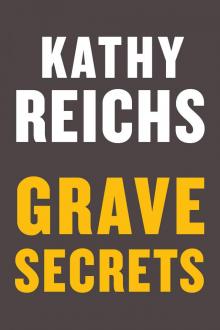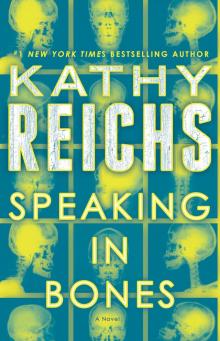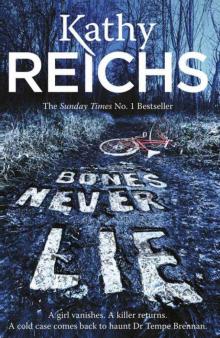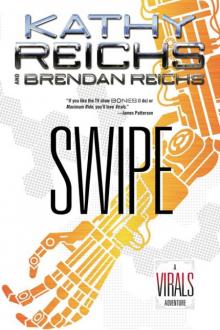- Home
- Kathy Reichs
Déjà Dead Page 7
Déjà Dead Read online
Page 7
“Who?” I asked.
“These women.”
The hookers? The murder victims?
“Which women?”
For several seconds she didn’t answer.
“I’m so sick of this shit!”
She was out of the car and up the stairs before I could react. Then her vehemence slapped me in the face.
FOR THE NEXT COUPLE OF WEEKS I HEARD NOTHING FROM GABBY. I was also not on Claudel’s dialing list. He’d cut me out of the loop. I learned about Isabelle Gagnon’s life through Pierre LaManche.
She’d lived with her brother and his lover in St. Édouard, a working-class neighborhood northeast of Centre-ville. She worked in a lover’s boutique, a small shop off St. Denis specializing in unisex clothes and paraphernalia. Une Tranche de Vie. A Slice of Life. The brother, who was a baker, had thought of the name. The irony of it was depressing.
Isabelle disappeared on Friday, April 1. According to the brother, she was a regular at some of the bars on St. Denis, and had been out late the night before. He thought he’d heard her come in around 2 A.M., but didn’t check. The two men left for work early the next morning. A neighbor saw her at 1 P.M. Isabelle was expected at the boutique at 4 P.M. She never showed up. Her remains were discovered nine weeks later at Le Grand Séminaire. She was twenty-three.
LaManche came into my office late one afternoon to see if I’d finished my analysis.
“There are multiple fractures of the skull,” I said. “It took quite a bit of reconstructing.”
“Oui.”
I took the skull from its cork ring.
“She was hit at least three times. This is the first.”
I pointed to a small, saucerlike crater. A series of concentric circles expanded outward from its epicenter, like rings on a shooting target.
“The first blow wasn’t hard enough to shatter her skull. It just caused a depression fracture of the outer table. Then he hit her here.”
I indicated the center of a starburst pattern of fracture lines. Looping through the stellate system was a series of curvilinear fractures. The rays and the circles interlaced to form a spiderweb of damage.
“This blow was much harder, and caused a massive comminuted fracture. Her skull shattered.”
It had taken long hours to reassemble the pieces. Traces of glue were visible along the fragment edges.
He listened, absorbed, his eyes driving back and forth from the skull to my face so intently they seemed to burrow a channel through the air.
“Then he hit her here.”
I traced a runner from another starburst system toward an arm of the one I’d just shown him. The second linear break came up to the first and stopped, like a country road at a T-intersection.
“This blow came later. New fractures will be arrested by preexisting ones. New lines won’t cross old ones, so this one had to have come last.”
“Oui.”
“The blows were probably delivered from the back and slightly to the right.”
“Oui.”
He did this to me often. The absence of feedback was no indication of a lack of interest. Or understanding. Pierre LaManche missed nothing. I doubt he ever needed second explanations. The monosyllabic response was his way of forcing you to organize your thoughts. A sort of dry-run jury presentation. I forged on.
“When a skull is hit it acts like a balloon. For a fraction of a second the bone pushes in at the point of impact, and bulges out on the opposite side. So the damage isn’t restricted to the place the head was struck.”
I looked to see if he was with me. He was.
“Because of the architecture of the skull, the forces caused by a sudden impact travel along certain pathways. The bone fails, or breaks, somewhat predictably.”
I pointed to the forehead.
“For example, an impact here can result in damage to the orbits or face.”
I indicated the back of the skull.
“A blow here often causes side-to-side fractures of the base of the skull.”
He nodded.
“In this case, there are two comminuted fractures and one depressed fracture of the posterior right parietal. There are several linear fractures that start on the opposite side of the skull and travel toward the damage in the right parietal. This suggests she was struck from the back and to her right.”
“Three times,” he said.
“Three times,” I confirmed.
“Did it kill her?” He knew what my answer would be.
“Could have. I can’t say.”
“Any other signs of cause?”
“No bullets, no stab marks, no other fractures. I’ve got some odd gashes on the vertebrae, but I’m not really sure what they mean.”
“Due to the dismemberment?”
I shook my head. “I don’t think so. They’re not in the right place.”
I replaced the skull in its ring.
“The dismemberment was very clean. He didn’t just chop the limbs off. He severed them neatly at the joints. Remember the Gagne case? Or Valencia?”
He thought a minute. In a rare display of movement he tipped his head to the right, then to the left, like a dog cuing in on the crinkle of cellophane.
“Gagne came in, oh, maybe two years ago,” I prompted. “He was wrapped in layers of blankets, trussed up with packaging tape. His legs had been sawed off and packaged individually.”
At the time it had reminded me of the ancient Egyptians. Before mummification they removed the internal organs and preserved them. The viscera were then bundled separately and placed with the body. Gagne’s killers had done the same with his legs.
“Ah, oui. I remember the case.”
“Gagne’s legs were sawed off below the knees. Same with Valencia. His arms and legs were cut several inches above or below the joints.”
Valencia had gotten greedy on a drug deal. He came to us in a hockey bag.
“In both those cases the limbs were hacked off at the most convenient place. In this case the guy neatly disconnected the joints. Look.”
I showed him a diagram. I’d used a standard autopsy drawing to indicate the points at which the body had been cut. One line ran through the throat. Others bisected the shoulder, hip, and knee joints.
“He cut the head off at the level of the sixth cervical vertebrae. He removed the arms at the shoulder joints, and the legs at the hip sockets. The lower legs were separated at the knee joints.”
I picked up the left scapula.
“See how the cuts surround the glenoid fossa?”
He studied the marks, sets of parallel grooves circling the joint surface.
“Same thing with the leg.” I switched the scapula for the pelvis. “Look at the acetabulum. He went right into the socket.”
LaManche inspected the deep cup that accommodates the head of the femur. Numerous gashes scarred its walls. Silently, I took the pelvis and handed him the femur. Its neck was ringed by pairs of parallel cuts.
He looked at the bone a long time, then returned it to the table.
“The only place he deviated was with the hands. There he just sliced right through the bone.”
I showed him a radius.
“Odd.”
“Yes.”
“Which is more typical? This or the others?”
“The others. Usually you want to cut a body up so it’s easier to dispose of, so you do it the fastest way possible. Grab a saw and hack away. This guy took more time.”
“Hmm. What does it mean?”
I’d given the question quite a bit of thought.
“I don’t know.”
Neither of us spoke for a few moments.
“The family wants the body for burial. I’m going to hold off as long as I can, but be sure you’ve got good pictures and everything you will need if we go to trial on this one.”
“I plan to take sections from two or three of the cut marks. I’ll look at them under the microscope to see if I can pinpoint the tool type.”
> I chose my next words carefully, and watched him closely for a reaction.
“If I get any good features I’d like to try comparing these cuts to some I have on another case.”
The corners of his mouth twitched almost imperceptibly. I couldn’t tell if it was amusement or annoyance. Or perhaps I’d imagined it.
After a pause he said, “Yes. Monsieur Claudel has mentioned this.” He looked directly at me. “Tell me why you think these cases are connected.”
I outlined the similarities I saw between the Trottier and Gagnon cases. Bludgeoning. Cutting of the body after death. The use of the plastic bags. Dumping in a secluded area.
“Are these both CUM cases?”
“Gagnon is. Trottier is SQ. She was found in the St. Jerome.”
As in many cities, questions of jurisdiction can be tricky in Montreal. The city lies on an island in the middle of the St. Lawrence. The Communauté Urbaine de Montréal police handle murders occurring on the island itself. Off the island, they fall to local police departments, or to La Sûreté du Québec. Coordination is not always good.
After a pause he said, “Monsieur Claudel can be”—he hesitated—“difficult. Follow through on your comparison. Let me know if you need anything.”
• • •
Later that week I’d photographed the cut marks with a photomicroscope, using varying angles, magnifications, and intensities of light. I hoped to bring out details of their internal structure. I’d also removed small segments of bone from several joint surfaces. I planned to view them with the scanning electron microscope. Instead I was up to my neck in bones for the next two weeks.
A partially clothed skeleton was discovered by kids hiking in a provincial park. A badly decomposed body washed up on the shore of Lac St. Louis. While cleaning the basement of their newly purchased home, a couple found a trunk full of human skulls covered with wax, blood and feathers. Each find came to me.
The remains from Lac St. Louis were presumed to be those of a gentleman who died in a boating mishap the previous fall when a competitor took exception to his freelancing as a cigarette smuggler. I was putting his skull back together when the call came.
I’d been expecting it, though not this soon. As I listened my heart raced and the blood below my breastbone felt fizzy, like carbonated soda shaken in a bottle. I felt hot all over.
“She’s been dead less than six hours,” LaManche was saying. “I think you’d better take a look.”
MARGARET ADKINS WAS TWENTY-FOUR. SHE HAD LIVED WITH HER common-law husband and their six-year-old son in a neighborhood nestled in the shadow of the Olympic Stadium. She was to have met her sister at ten-thirty that morning for shopping and lunch. She didn’t make it. Nor did she take later phone calls after speaking with her husband at ten. She couldn’t. She’d been murdered sometime between his call and noon, when her sister discovered her body. That was four hours ago. That’s all we knew.
Claudel was still at the scene. His partner, Michel Charbonneau, sat on one of the plastic chairs lining the far wall of the large autopsy suite. LaManche had returned from the murder scene less than an hour ago, the body preceding him by minutes. The autopsy was underway when I arrived. I knew immediately that we’d all work overtime that night.
She lay facedown, her arms straight against her sides, hands palm up with the fingers curving inward. The paper bags placed on them at the scene had already been removed. Her fingernails had been inspected and scrapings taken. She was nude, and her skin looked waxy against the polished stainless steel. Small circles dotted her back, pressure points left by drainage holes in the table’s surface. Here and there a solitary hair clung to her skin, estranged forever from the curly tangle on her head.
The back of her head was distorted, the shape slightly off, like a lopsided figure in a child’s drawing. Blood oozed from her hair and mingled with the water used to clean her, gathering below the body in a translucent, red pool. Her sweat suit, bra, panties, shoes, and socks had been spread across the adjacent autopsy table. They were saturated with blood, and the sticky, metallic smell hung heavy on the air. A Ziploc bag next to the sweats held an elasticized belt and sanitary pad.
Daniel was taking Polaroids. The white-bordered squares lay on the desk next to Charbonneau, their emerging images in varying degrees of clarity. Charbonneau was inspecting them, one by one, then carefully returning each to its original place. He chewed on his lower lip as he studied them.
A uniformed officer from identity was shooting with a Nikon and flash. As he circled the table, Lisa, newest of the autopsy technicians, positioned an old-fashioned screen behind the body. The painted metal frame, with its shirred white fabric, belonged to an era when such paraphernalia were used in hospital rooms to barricade patients during intimate procedures. The irony was jarring. I wondered whose privacy they were trying to protect here. Margaret Adkins was past caring.
After several shots the photographer stood down from his stool and looked questioningly at LaManche. The pathologist stepped closer to the body and pointed to a scrape on the back of the left shoulder.
“Did you get this?”
Lisa held a rectangular card to the left of the abrasion. On it were written the LML number, the morgue number, and the date: June 23, 1994. Both Daniel and the photographer took close-ups.
At LaManche’s direction, Lisa shaved the hair from around the head wounds, spraying the scalp repeatedly with a nozzle. There were five in all. Each showed the jagged edges typical of blunt instrument trauma. LaManche measured and diagrammed them. The cameras captured them in close-up.
At length LaManche said, “That should do it from this angle. Please turn her back over.”
Lisa stepped forward, momentarily blocking my view. She slid the body to the far left side of the table, rolled it back slightly, and snugged the left arm tightly against the stomach. Then she and Daniel turned the body onto its back. I heard a soft thunk as the head dropped onto the stainless steel. Lisa lifted the head, placed a rubber block behind the neck, and stepped back.
What I saw made my blood race even faster, as if the thumb had been slipped from the shaken soda bottle in my chest and a geyser of fear allowed to erupt.
Margaret Adkins had been ripped open from her breastbone to her pubis. A jagged fissure ran downward from her sternum, exposing along its course the colors and textures of her mutilated entrails. At its deepest points, where the organs had been displaced, I could see the glistening sheath surrounding her vertebral column.
I dragged my eyes upward, away from the terrible cruelty in her belly. But there was to be no relief there. Her head was turned slightly, revealing a pixie-like face, with upturned nose and delicately pointed chin. Her cheeks were high and sprinkled with freckles. In death, the tiny brown splotches stood out in sharp contrast to the surrounding white in which they floated. She looked like Pippi Longstocking in short brown hair. But the little elf mouth was not laughing. It was stretched wide, and a severed left breast bulged from it, the nipple resting on the delicate lower lip.
I looked up and met LaManche’s eyes. The lines paralleling them seemed deeper than usual. There was a tension to the lower lids that caused the sagging parenthesis under each to twitch slightly. I saw sadness, but perhaps something more.
LaManche said nothing and continued the autopsy, his attention shifting back and forth between the body and his clipboard. He recorded each atrocity, noting its position and dimensions. He detailed every scar and lesion. As he worked, the body was photographed from the front as it had been from the back. We waited. Charbonneau smoked.
After what seemed like hours, LaManche finished the external exam.
“Bon. Take her for radiography.”
He stripped off his gloves and sat down at the desk, hunching over his clipboard like an old man with a stamp collection.
Lisa and Daniel rolled a steel gurney to the right of the autopsy table. With professional agility and detachment they transferred the body and wheeled it off to be
X-rayed.
Silently, I moved over and took the chair next to Charbonneau. He half rose, nodding and smiling in my direction, took a long pull on his cigarette, and stubbed it out.
“Dr. Brennan, how goes it?”
Charbonneau always spoke to me in English, proud of his fluency. His speech was an odd mixture of Québecois and Southern slang, born of a childhood in Chicoutimi, embellished by two years in the oil fields of east Texas.
“Good. And you?”
“Can’t complain.” He shrugged in a way only francophiles have mastered, shoulders hunched, palms raised.
Charbonneau had a wide, friendly face and prickly gray hair that always reminded me of a sea anemone. He was a large man, his neck disproportionately so, and his collars always looked tight. His ties, perhaps in an attempt to compensate, either rolled over and slipped sideways, or disengaged themselves and hung below the level of his first shirt button. He’d loosen them early in the morning, probably hoping to make the inevitable look intentional. Or maybe he just wanted to be comfortable. Unlike most of the CUM detectives, Charbonneau did not try to make a daily fashion statement. Or maybe he did. Today he wore a pale yellow shirt, polyester pants, and a green plaid sports jacket. The tie was brown.
“Seen the prom pics?” he asked, reaching to retrieve a brown envelope from the desk.
“Not yet.”
He withdrew a stack of Polaroids and handed them to me. “These are just the backup shots that came in with the body.”
I nodded and began going through them. Charbonneau watched me closely. Perhaps he hoped I would recoil from the carnage so he could tell Claudel I’d blinked. Perhaps he was genuinely interested in my reaction.
The photos were in chronological order, re-creating the scene as the recovery team had found it. The first showed a narrow street lined on both sides by old but well-kept buildings, each three stories high. Parallel rows of trees bordered the curbs on each side, their trunks disappearing into small squares of dirt surrounded by cement. The buildings were fronted by a series of postage-stamp yards, each bisected by a walkway leading to a steep metal staircase. Here and there a tricycle blocked the sidewalk.

 Two Nights
Two Nights The Bone Collection: Four Novellas
The Bone Collection: Four Novellas Fatal Voyage
Fatal Voyage 206 Bones
206 Bones Bones to Ashes
Bones to Ashes Terminal
Terminal Monday Mourning
Monday Mourning Flash and Bones
Flash and Bones Cross Bones
Cross Bones Devil Bones
Devil Bones Break No Bones
Break No Bones Swamp Bones
Swamp Bones Déjà Dead
Déjà Dead Shock
Shock Spider Bones
Spider Bones Death Du Jour
Death Du Jour Grave Secrets
Grave Secrets Trace Evidence: A Virals Short Story Collection
Trace Evidence: A Virals Short Story Collection Bones on Ice
Bones on Ice The Bone Code
The Bone Code Bones in Her Pocket
Bones in Her Pocket Seizure:
Seizure: Speaking in Bones
Speaking in Bones Deadly Decisions
Deadly Decisions Spike
Spike Bones Never Lie
Bones Never Lie Bones of the Lost
Bones of the Lost Virals 03.5 - Swipe
Virals 03.5 - Swipe Exposure
Exposure A Conspiracy of Bones
A Conspiracy of Bones Shift (tory brennan)
Shift (tory brennan) Bones of the Lost: A Temperance Brennan Novel tb-16
Bones of the Lost: A Temperance Brennan Novel tb-16 Virals tb-1
Virals tb-1 Bones Are Forever tb-15
Bones Are Forever tb-15 Code tb-3
Code tb-3 Seizure tb-2
Seizure tb-2 Deadly Descisions
Deadly Descisions Spider Bones: A Novel
Spider Bones: A Novel